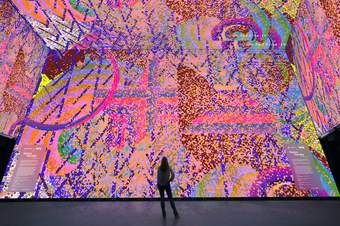
Installation view of Samia Halaby, Tottenham Court Road 2024 at Outernet London
In celebration of the opening of Tate Modern’s major new exhibition, Electric Dreams: Art and Technology Before the Internet later this month, a new collaboration between Outernet London and Tate will bring the colourful abstract art of Palestinian-American artist Samia Halaby to the heart of the city. Recognised as one of the early innovators of digital art in the 1980s, Halaby – whose work is included in Electric Dreams – is known for creating dynamic geometric paintings that explore the relationship between art and technology. Specially commissioned for Outernet’s floor-to-ceiling wrap around screens, two brand new works by Halaby will be brought to life for the first time alongside the experimental and rhythmic sounds of celebrated electronic musician, Four Tet. Together they offer visitors an immersive and sensory environment full of colour and movement, available to view for free at Outernet’s flagship space The Now Building from 14 November 2024 until 31 March 2025.
Titled Tottenham Court Road and After the Green and After the Black Dune 2024, Halaby’s two new site-specific commissions will be joined by Brass Women 1995/2019, one of the artist’s most iconic works from her Kinetic Painting Group series. Consisting of vivid, brightly coloured geometric shapes and slanting lines which shift restlessly in all directions, Halaby calls these moving abstract animations ‘kinetic paintings’. Accompanied by layered soundtracks, they exist in motion, as dynamic forms that change over time and in tandem with the music. She originally began creating her kinetic works after teaching herself how to code on a Commodore Amiga 1000, one of the first widely available personal computers released in 1985. Reimagined for the five 23,000 sq ft screens at Outernet, the works presented were made using a computer programme Halaby developed between 1990-1996. For Halaby, these early developments in technology allowed her to push the boundaries of painting and explore new forms of language.
Sound is a key element to Halaby’s work, with the artist often collaborating with musicians using both acoustic and electronic instruments. For this significant commission, Halaby has joined forces with Four Tet, the moniker of London-based producer Kieran Hebden, known for blending electronic music with elements of jazz, folk, and hip-hop, to create atmospheric, experimental soundscapes. Halaby’s colourful kinetic works are set to Four Tet’s layered and textured sounds, taking viewers on an epic sensory journey.
Halaby’s deep-rooted interest in technology, both as a subject and a tool in her artistic process, adds a unique dimension to this collaboration with Outernet London - the most visited cultural attraction in the UK, home to the most advanced giant screens in the world. As an innovator who became one of the first artists to experiment with computer-generated art in the early 1980s, her forward-thinking approach resonates with Outernet’s mission to redefine how people experience art, media, and culture through technology and immersive storytelling.
Visitors will be able to view more work by Halaby alongside an international network of more than 70 artists working between the 1950s and the dawn of the internet age, as part of Tate Modern’s Electric Dreams exhibition from 28 November 2024 to 1 June 2025. Spotlighting groundbreaking figures from across Asia, Europe and the Americas who responded to the growing presence of technology in our lives by finding new ways to work with machines, this ambitious exhibition will be a rare opportunity to experience incredible vintage tech art in action - from mesmerising psychedelic installations to early experiments made with home computers and video synthesisers.
